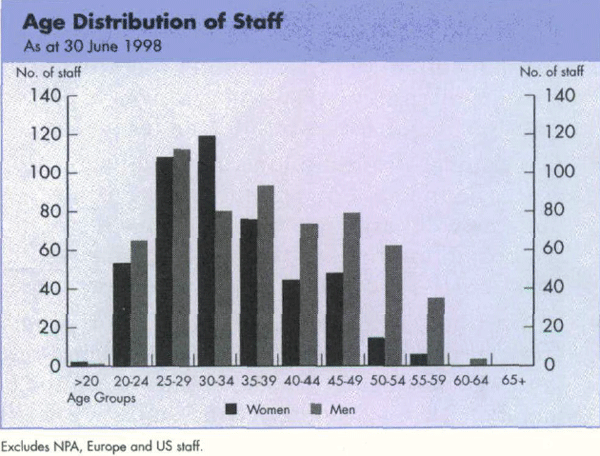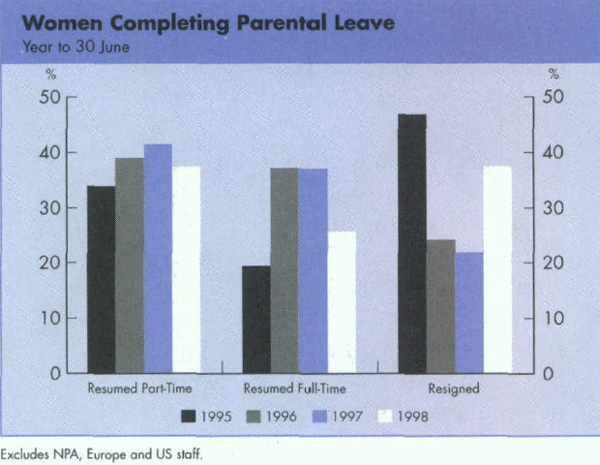Equal Employment Opportunity Annual Report – 1998 Evaluation of the Program
Key Indicators
The data and analysis set out below, together with statistics in Appendices 4 and 5, provide a measure of progress of the four designated EEO groups within the Bank, and a benchmark for appropriate future action. Overall staff numbers declined this year by 212, a similar decline as last year (219). The largest reduction occurred in the Business Services Group which was restructured to improve efficiency and respond to business pressures. A new Payments Settlements Department was also established within the Group. Elsewhere, Personnel Policy Department was reorganised into a smaller strategic unit, and changed work requirements led to staff reductions in Audit and the Corporate Services Group. A decision was also taken that “in-house” Head Office catering arrangements could be handled more efficiently by an external provider.
Occupational groupings have been analysed using the Australian Standard Classification of Occupations (ASCO) codes from the Australian Bureau of Statistics. These are described more fully in Appendix 3.

Women
- Women represent 44% of the Bank's staff; this is the same as last year. When the EEO statistics were first collected in 1987 48% of staff were women. This gradual decline has been largely due to the impact of technology and the resultant loss of clerical jobs and for this year, cafeteria staff. Just under half of the Bank's staff are engaged in clerical occupations. Of these, 61% are held by women, compared to 87% in 1991.

- 52% of the Bank's staff are in managerial or professional positions. 30% of these positions are held by women. Since 1991, the proportion of women at supervisory/management level has continued to increase. The proportion of management positions filled by women (Level 5 and above) has expanded from 8% to 18% over these seven years.
- For the first time, resignations and retirements are shown in separate tables. Of the 264 staff who resigned from the Bank this year, 49% were women, compared to last year's 38%. Redundancies account for just over 50% of all resignations. The main reason for resignation for both men and women continues to be concerns about career progression (promotion opportunity, long term career path and staff appraisal).

- As a group, women are younger than men, but this difference is narrowing. At year end, 50% of total Bank staff were under the age of 35; 52% of women, compared to 43% of men are under the age of 35. There has been a significant reduction for women compared to last year when 61% of women were under the age of 35. It would appear that the redundancies of 1997/98 has had the greatest impact on this age group of women.
People from Non-English Speaking Backgrounds
- The representation of people from non-English speaking backgrounds (NESB1 and NESB2) has increased slightly from 23% last year to 25% of staff overall. In 1991 it was 19%.
- Overall, 18% of total Bank staff are in management positions (Level 5 and above). The proportion of management positions filled by staff from non-English speaking backgrounds is 13%.
- 42% of the staff from non-English speaking backgrounds are in professional/associate professional occupations, which is not significantly different from staff as a whole where 45% are in these occupations.
People with Disabilities and Aboriginal and Torres Strait Islander People
- The representation of Aboriginal and Torres Strait Islander people has remained the same as last year.
- The representation of people with disabilities has also remained the same as last year. The Bank's reported representation of people with disabilities could be an under-estimate because staff who have acquired disabilities since the 1987 EEO Staff Survey are not identified in the database.
Staff Selection
- Recruitment declined again from 113 last year to 83 this year. Factors behind the decline are the outsourcing of the catering function, which had a high turnover of staff, and the implementation of further Bank restructuring which will reflect in the next reporting period. Of the staff recruited, 47% were women, 47% were from non-English speaking backgrounds, and 4% were people with disabilities.
- The lower representation of women is unusual but reflects that, increasingly, vacancies are arising in professional rather than clerical occupations, and in the professional disciplines relevant to the Bank, male applicants predominate. Women represented 31% of applicants for new graduate positions and 26% of the actual intake, an improvement on last year's 17% of actual intake.
- The Bank offered 13 places under the Australian Traineeship Program during the year – 9 recruits were women, 1 was a person with a disability and 1 was a Aboriginal and Torres Strait Islander person.
- The number of promotions increased significantly from 80 last year to 146 this year. The increase in promotions has come about through the establishment of three new departments and extensive restructuring in most other areas. Overall the promotion rate for women has improved to 13% compared to 14% for men. Last year the promotion rate was 5% for women and 8% for men.
- During the year around 223 staff selection panels were conducted for both internal and external position applicants. All panels have a representative of Personnel Policy Department. Of these 19% were chaired by a woman and 81% had a female member. This is a slight decline on last year's figures where 23% of panels were chaired by a woman and 85% had a female member.
Career Development & Staff Training
- Of all Bank staff 67% attended some formal internal training during the year; the rates for all EEO groups were similar. The rates for attendance at external training were lower than for internal training: around 32% for women compared to 49% for men. Sixteen women attended the Springboard program and two senior women were mentors for the program. The attendance rate for Springboard has doubled since last year.

- Overall 14% of staff received study assistance over the year. 15% of men undertook assisted study compared to 12% of women. The lower representation of women occurs at classification Level 3 and below. For example, 23% of Level 3 men compared to 11% of Level 3 women received study assistance – unusual because there are equal numbers of men and women at this level.
- There were 138 formal internal staff transfers during the year. This is a significant increase from last year's 92. The overall transfer rate was 10% for women and 15% for men. A number of departments were restructured and three new departments established so the transfer figure does not include appointments at level to new positions within the new structures (316 appointments in total).

Conditions of Employment
- 9% of women and 5% of men took paid parental leave during the year. 59% of women who returned to work from parental leave had been away for up to 12 months. The men were away for an average of 5 days (total paid entitlement).
- The number of resignations from parental leave was significantly higher this year. Of those women completing parental leave during the year, only 63% returned to work. This is the lowest return rate since 1995 and is mainly due to redundancies in business areas where a higher proportion of women were on parental leave. Of those who returned to work nearly 60% returned part time. At NPA two women returned to work after parental leave, both to full-time positions; there were no resignations directly from parental leave.

- During the year 31 salaried female staff worked part time (4 permanent, 5 temporary and 22 contiguous with parental leave). At NPA two women worked part time during the reporting period.
- As was the case last year around one third of staff took carer's leave during the year. It was used equally by men and women and the average number of days was 2.6.